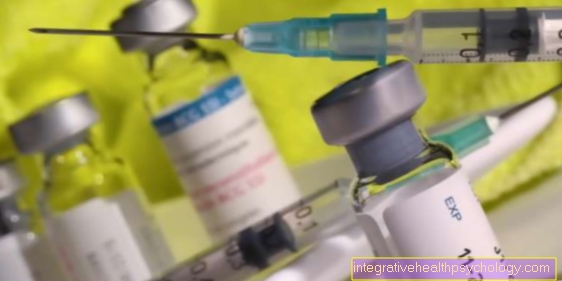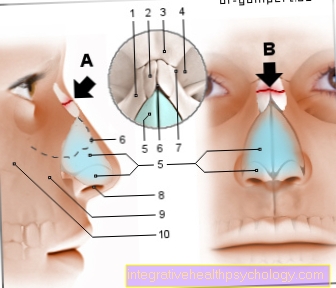Discography
Synonyms in a broader sense
Discography, spondylodiscitis, spondylitis, discitis, disc inflammation, vertebral body inflammation
English: discography
Definition of discography

A discography is a small surgical procedure that is only performed under local anesthesia. It is a diagnostic procedure with v.a. disc-related back pain (Discopathy) (read also: herniated disc)
A discopathy describes the clinical picture of one Back pain causative Intervertebral disc as part of their aging process. As pain-transmitting nerve fibers grow into the disc tissue, pain is transmitted from inside the disc. Otherwise there are no nerve fibers in the core of an intervertebral disc in a healthy state. Discopathy is most common in the lumbar spine. A herniated disc is also a discopathy in the broader sense. However, the orthopedist working in the clinic differentiates between these clinical pictures.
root cause

The indication (display) to carry out the Discography is asked as part of a cause of back pain that needs to be clarified. Indications for back pain caused by the intervertebral disc can already be found in the medical history (anamnese) of patients deliver. A characteristic of intervertebral disc-related back pain is that patients often report it in the morning through their Back pain to be driven out of bed. Long lying in bed makes the symptoms worse. The symptoms initially improve by standing up and moving. If the back is overloaded, however, the pain will increase again. This description of the complaint is only intended as a guide. The actual complaints of the patients vary from person to person. The presence of concomitant diseases, such as the wear and tear of the small vertebral joints (Facet syndrome) plays an important role, as the signs (symptoms) of the facet syndrome can be very different from the symptoms of discopathy.
Magnetic resonance imaging of the spine (MRI) is another sign of a diseased intervertebral disc. Here the aging process of an intervertebral disc can be directly traced. Intervertebral discs suspicious for discopathy appear black in the MRI in the T2 weighting (black disc), i.e. they no longer have a liquid core (Intervertebral disc), which in a healthy intervertebral disc is shown brightly on the MRI images that are usually made. The loss of water from an intervertebral disc is an indication of its aging process. Since the wear and tear of the intervertebral disc does not necessarily have to cause back pain, in some cases further examination by means of a discography is necessary.
Please also read our special topics:
- MRI for a herniated disc
and - MRI of the spine
The need for a discography is usually present in the context of an operation planning, if it is to be clarified which intervertebral discs must be included in the operation (Intervertebral disc prosthesis, spinal fusion).
Procedure of discography
A Discography is carried out under inpatient conditions in the operating room. It is a minor surgical procedure. The day before the patient is informed about the surgical procedure and the general and procedure-specific complications by the doctor and must give his written consent for the procedure. It is important to clarify any contrast medium allergies in the patient's history, as the use of X-ray contrast medium in the case of an existing allergy can lead to it severe allergic reactions, up to allergic shock (Cardiac arrest) can come.
A anesthesia is neither necessary nor desired. The patient is placed on his stomach in the operating room, the operating area is disinfected and covered with sterile cloths. First of all, the suspects are found Intervertebral disc with a mobile X-ray machine (Imager). After the identification of the intervertebral disc, the puncture channel for the contrast agent injection is marked with a Local anesthetic stunned. Then the intervertebral disc space is accessed with a thin needle (cannula). The puncture canal for puncturing the intervertebral discs on the lumbar spine runs obliquely from the posterior iliac crest. This is experienced by many patients as unpleasant despite local anesthesia. In this case, the anesthetist (anesthetist) can enter via the vein Painkiller administer. The needle is placed in the disc space under X-ray control. Then the X-ray contrast agent is injected into the intervertebral disc.
Diagnostic effects of discography
- By the Injection of the contrast agent the disc structure becomes visible on the X-ray. Without a contrast medium, the intervertebral discs are on a X-ray shown only as empty spaces between the adjacent vertebral bodies. The distribution of the contrast medium allows conclusions to be drawn about the disease state of the intervertebral disc. A loss of contrast medium from the intervertebral disc body, for example, shows one fracture in the intervertebral disc ring.
- Above all, however, the injection (injection) securing the cause of back pain. The injection of the contrast medium leads to an increase in pressure in the intervertebral disc space, which in the case of a diseased intervertebral disc leads to a pain provocation. During the injection, the patient should feel exactly the pain he is familiar with and articulate this to the doctor. If this is the case, one speaks of a positive distension test. If no pain is provoked, the distension test is negative and the cause of the back pain remains unexplained, or the cause of the back pain is not caused by this intervertebral disc.
The problem with the discography is that Subjectivity of Pain Differentiation through the Patient. The doctor cannot objectively verify the patient's information and must rely on his judgment. Because of this, some doctors have questioned the importance of this procedure.
Figure discography
- Disc space
- Discography needle
- Contrast medium display of the L4 / 5 intervertebral disc
Discography in CT
- Contrast medium leakage into the spinal canal (defective disc ring)
- Spinal canal

Complications
Complications after a discography are very rare. Theoretically, secondary bleeding is possible through damage to blood vessels in the course of the puncture direction. Injury to a nerve root by the needle is theoretically possible. However, due to the doctor's anatomical knowledge and the continuous position control of the needle during the puncture, the risk is very low. Despite careful disinfection, the spread of germs (bacteria) into the disc space cannot be completely ruled out. As already mentioned, an unknown contrast agent allergy can lead to allergic shock.




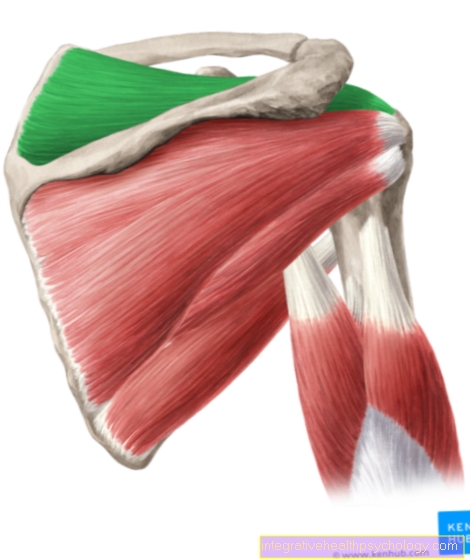
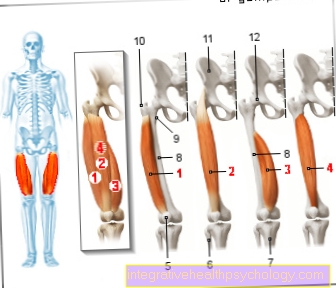
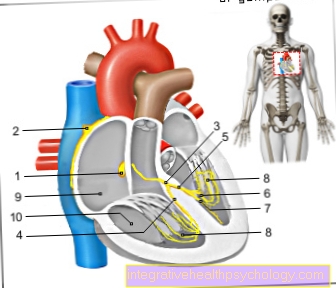
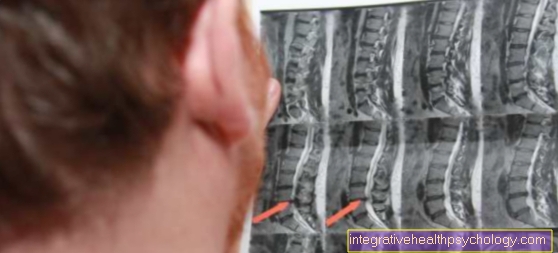



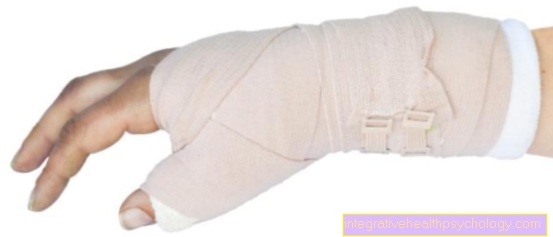
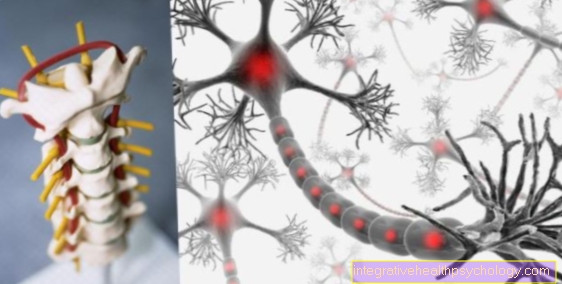



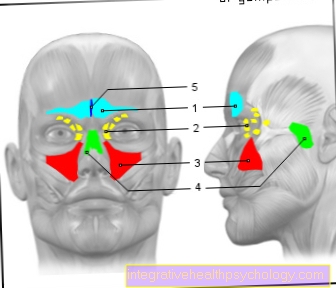
.jpg)


